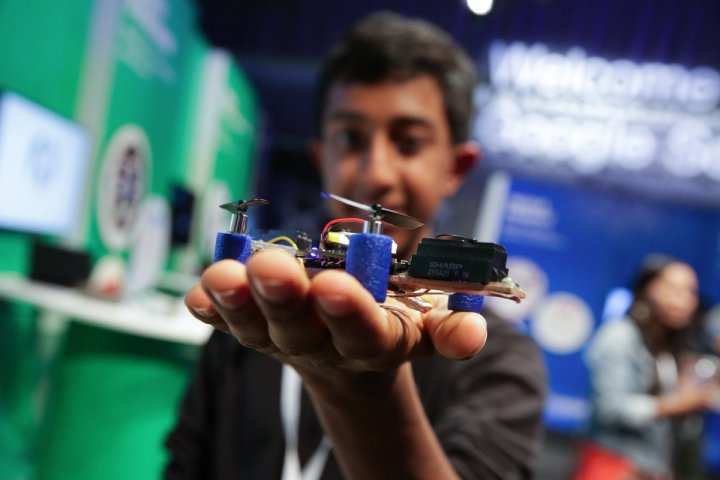
But their prowess for problem solving doesn’t stop at the computer. The projects kids make at science fairs nowadays easily beat out the smelly potato batteries and homemade volcanoes you remember making when you were their age. From flying robots to a Lego spacecraft, these are some of our favorite science fair projects.
Lego Loki Launcher
Sisters Kimberly and Rebecca Yeung had one simple mission: Launch their cat into space. Kimberly and Rebecca were only nine and eleven-years-old at the time, but they were able to successfully launch their spacecraft 78,000 feet into the air with a GoPro and tracking devices attached so they could analyze the data and take in the view from (near) space. Lego Loki Launcher was able to take flight with a weather balloon, and once it popped at its peak, a parachute deployed and the craft came back down a mile of its launch site.
Their project caught the attention of President Obama, and it was featured at the final White House Science Fair in 2016. And don’t worry, they didn’t actually send their cat into space, just a picture of him, along with a lego R2D2.
Wearable sensors for Alzheimer patients
Kenneth Shinozuka’s grandpa is one of more than 5 million Americans who suffer from Alzheimer’s. Even though his grandpa lives with him and his family, it was still difficult to notice when he would get out of his bed and wander around, and potentially hurt himself.
So at 15, Shinozuka did something about it. He built a slim sensor for his grandpa to wear on his heel, and every time he stepped out of bed his family would be alerted on their phones via the app he developed. Shinozuka’s work earned him honors at the Google Science Fair, a $50,000 scholarship, and the Scientific American Science in Action Award.
Robots that fly and avoid danger
Fruit flies suck, but Mihir Garimella loves them. Probably because they helped inspire his flying robot design and win him top honors in the 13-14 age category at the Google Science Fair in 2014.
After months of coding and tinkering with sensors, Garimella developed a lightweight sensor module and attached it to a small drone body that he built. Just like a fly, Garimella’s robot can avoid dangers, and he’s hoping that future improvements to his design will allow his robot to be used for rescue missions in unpredictable environments like collapsed buildings.
A robot to clean New York’s subways
High school friends Amro Halwah, Stephen Mwingria, and Si Ya Ni, used to always be late to class.
They’d always be late because they had to take the New York subway to get to school, and the system was always delayed because of rubbish fires in the tunnels. The three of them decided enough was enough, and with the help of a grant from MIT, they built a 100-pound robot that moves on rails and vacuums up debris in the tunnels, so that no more fires could ignite. Their robot isn’t used by subways yet, but it was featured at the White House Science Fair.
Help ambulances move through traffic
Traffic is a nuisance to us, but for ambulances it’s life or death. Viney Kumar realized this after he visited India when he was 14 years old and saw an ambulance stuck in traffic for nearly an hour. It upset Kumar that there wasn’t a better way for ambulances to travel, so he decided to do something about it.
When he went back home to Australia, he started work on a transmitter to alert drivers of when an ambulance is nearby. By installing his transmitter in an ambulance, drivers with Kumar’s app will be alerted when an emergency vehicle is within 800 and 500 meters. This gives drivers 67 seconds to respond to an ambulance, which is way better than the current average of 14 seconds. Kumar’s amazing project won at the Google Science Fair for his age group, and he’s hoping that companies like Google and Apple will consider putting his technology in the dashboards they’re building for cars.


